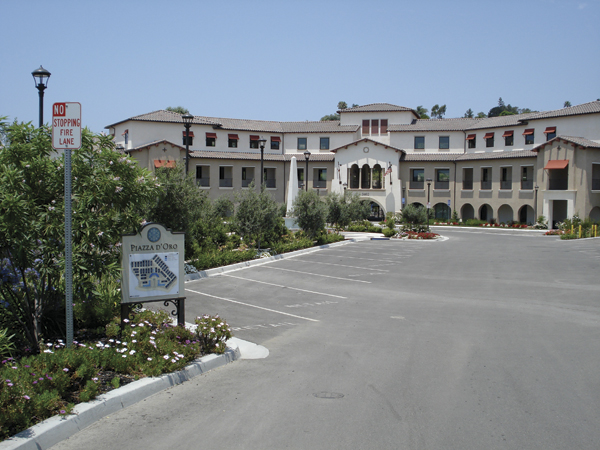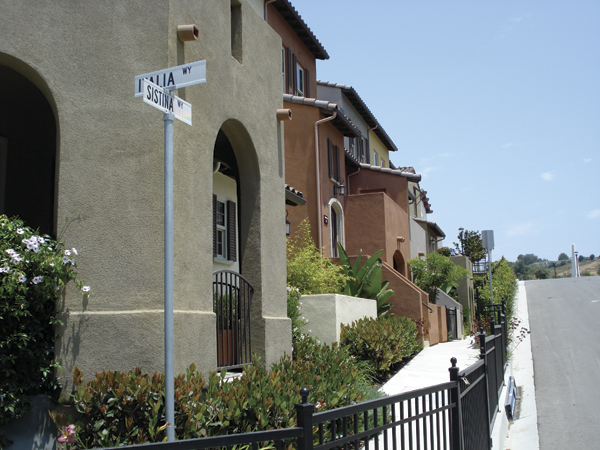|
Behind the Tuscany Craze
The Illusion of History
By Kristin Reichardt Kirwan
The scene is set: the golden sunset of a late afternoon illuminates the vineyards of a Tuscan villa. Waves of relatives and neighbors, who stop by unannounced throughout the day, wend their way through the crumbling terra cotta stone paths, their laughter bringing still more warmth to the gathering. Rustic casks bear copious amounts of footcrafted wine, lovingly stomped from the villa's own grapes. The festivities extend into the evening hours, without care for the next day's work.

The curiously empty parking piazza at Piazza d'Oro development in Oceanside.
|

The intersection of Italia Way & Sistina Way at Hovnanian Homes in Oceanside.
|
Variants of this apparently irresistible scenario have crept into nearly every conceivable marketing niche during the past decade. From Fancy Feast Tender Turkey Tuscany cat food to Tuscan Plaid, a Pottery Barn fabric pattern, to entire housing developments, the new millennium has seen the flourishing of all things "Tuscan": a fascination with that which evokes an earthy, simple, centuries-old vision of the central Italian countryside. Planned communities with names like "Piazza d'Oro" and "Toscana" sprout up in American suburbia, thousands of miles from their inspiration (try Googling the terms "planned community" and "Tuscan/Tuscany," for tedious starters). The interior colors of the Gaslamp Quarter restaurant Trattoria La Strada "evoke ideas of a Tuscan villa," according to its website. But why Tuscany, and why now?It is an unfortunate tendency of Americans, and particularly Californians, to neglect, destroy, and replace our historic sites and buildings as a way of periodically remaking our image. It is no coincidence that we have co-opted a region in which permanence and an incredibly rich cultural history are a given; somewhere in our national conscience, there must be a craving for more than the ephemeral. The ever-popular rustic look, seen also in the "shabby chic" decor of the 90s, can now be purchased pre-crumbled, pre-stained, and pre-well-used, bringing the illusion of history to a society that is increasingly disposable and transient. Tuscany brings to mind, whether real or imagined, Old World cultures in which people merely "work to live." Unfortunately, the commodification of history can come with a very modern price tag, requiring us to work ever harder to afford our predigested antiquity. A "Tuscan Treasure" advertised in the August 2008 issue of San Diego Home/Garden Lifestyles offers 7,000 square feet of living space and a 7-car garage. This "newly constructed magnificent Tuscan estate" can be yours for an unpeasantlike $2,300,000-$2,600,000, approximately 1.7% of Tuscany's gross domestic product of 2005 (courtesy of the DISTRICT Regional Framework Operation).
The pairing of rusticity with prohibitive cost is not the phenomenon's only incongruence. On the one hand, as ties with our neighbors and community weaken and families become more insular, we crave "the simple life," or at least its façade: the romanticized vision of wine-soaked celebrations with friends, neighbors, and extended family. In reality, gated communities, houses that are far larger than need be, and an overscheduled family life tend to preclude such relations, which can frankly end up being messier than we are willing to deal with. For example, the locale of a "grand Tuscan villa" in Del Mar's Santaluz development is advertised as not only a gated community, but an "exclusive gated community." The idea of exclusion, however, would likely be at odds with the traditional values of Italian culture. This "Authentic Tuscan Estate" in Del Mar, another oxymoron, promises "the ultimate in fine craftsmanship, detail and imported materials, transporting you into the ambiance of Old World European culture." At least the advertising copy is truthful: it is the "ambiance" of Old World European culture that is craved, rather than the culture itself.
The appetite for all things Tuscan prompts an examination of American culture: what it is and what makes it so. The Greek Revival architectural style was popularized in the antebellum South due partially to a reverence for the democracy of ancient Greece (which, incidentally, permitted slavery), while the Spanish Revival style thrived after the 1915 Panama-California Exposition, at a time when Californians were still intrigued by their state's Spanish heritage. The current obsession seems to be more a phenomenon of the Western states, particularly California and Nevada. This could be because other regions of the country, with their earlier patterns of settlement, have firmer roots in their ethnic populations, or because the large open spaces of the West are more conducive to the McVilla. It's difficult to imagine the Tuscan craze catching on in, say, Connecticut. But after Westerners reach the Tuscan saturation point, certainly a moment which is overdue, what will the next wave be?
We should be so lucky if the Tuscans had enough California culture to appropriate, were this a reciprocal agreement. Perhaps the boot of Italy is on the cusp of a California Craftsman architectural craze; maybe Italian cats will soon feast on fish taco-flavored cat food. But if instead the Tuscans find themselves racking their brains for some of our regional culture to borrow, it may be worthwhile to consider the ultimate benefit of historic preservation: not as the aesthetic safeguarding of individual buildings, but rather as a collective preservation, and thus an appreciation, of a region's culture. There has been quite a lot of impassioned discussion this year about patriotism; specifically, what constitutes it and who practices it. Another facet of this complex concept must surely be respect for the physical history of one's own country, an effective acknowledgement that our own culture is worth preserving.
Author Kristin Reichardt Kirwan, Ph.D., is a native San Diegan and a freelance writer specializing in topics related to architecture, design, and history. She lives in Carlsbad with her husband and daughter. All photos are by the author.
|
MORE FROM THIS ISSUE
From the Editor
2008 Most Endangered List of Historic Resources
Character Matters
Smart Growth - or is it?
The Impact of Historic Districts
Washington Didn't Sleep Here
How to Research Your House
Preserving Community Character
Behind the Tuscany Craze
2008 People In Preservation Award Winners
Preservation Community
Reflections
Annual Financial Report
Book Review - Working Windows
Sherlock Homes
Speakers Bureau Forming
Lost San Diego
Strength in Numbers
Advertisements
DOWNLOAD full magazine as pdf (16mb)
|





